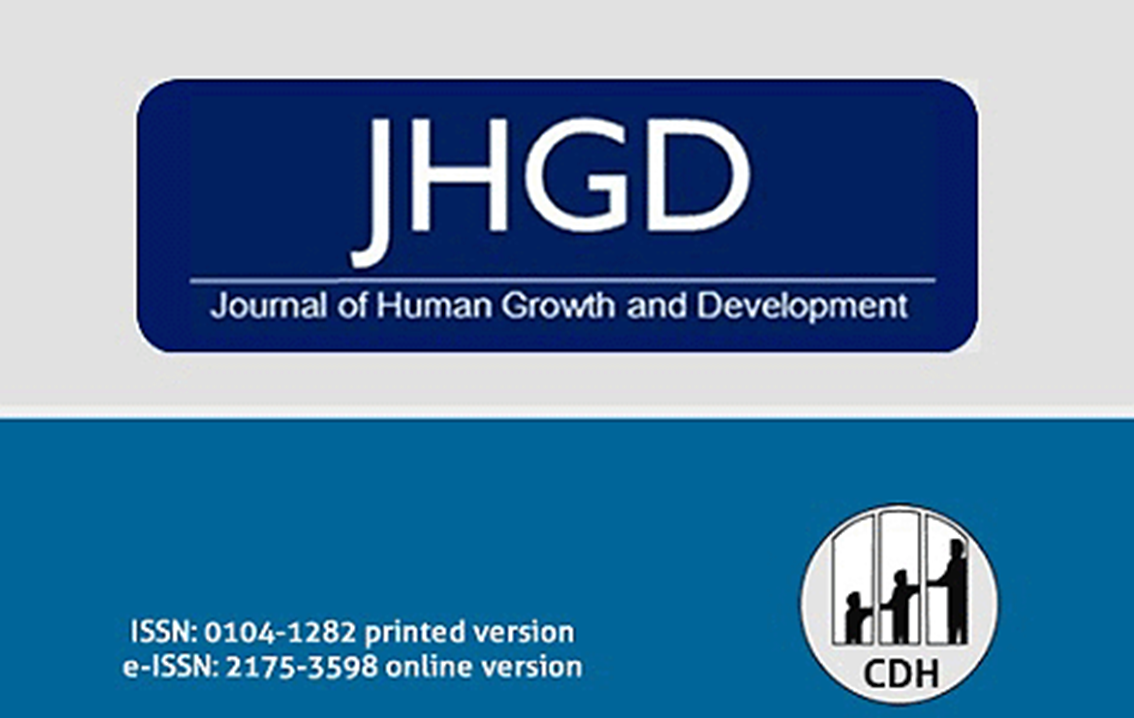Establishing a normative table for classifying body fat percentage in adolescents
DOI:
https://doi.org/10.36311/jhgd.v32.11542Keywords:
adiposity, adolescent health, body composition, body mass index, bioelectrical impedanceAbstract
Introduction: The prevalence of obesity in adolescents has increased worldwide, which is closely related to comorbidities in adulthood. Despite the severity of this pathology and its significant impacts on the health system, there is no international consensus on the cut-off point for the percentage of body fat for Brazilian children and adolescents, making it difficult to make an accurate and early diagnosis addition to assertive treatment.
Objective: This study aimed to establish cut-off points for body fat percentage in male and female adolescents aged 16 to 19 years using bioelectrical impedance (InBody 570®).
Methods: Gender-specific tables were proposed based on the percentiles 3, 5, 10, 15, 25, 50, 75, 85, 95, and 97. A total of 546 adolescents were included.
Results: The body fat percentage cut-off points for the male group were: P3 = 6.0-7.0%; P5 = 7.1-8.9%; P10 = 9.0-9.8%; P15 = 9.9-11.7%; P25 = 11.8-15.5%; P50 = 15.6-21.9%; P75 = 22.0-27.8%; P85 = 27.9-36.0%; P95 = 36.1-38.0% and P97 ≥ 38.1%. For females, the cut-off points were: P3 = 9.5-10.0%; P5 = 10.1-11.0%; P10 = 11.1-11.8%; P15 = 11.9-14.0%; P25 = 14.1-19.0%; P50 = 19.1-27.1%; P75 = 27.2-29.0%; P85 = 29.1-39.9%; P95 = 40.0-51.0% and P97 ≥ 51.0%.
Conclusion: The establishment of cut-off points for body fat percentage may improve the clinical assessment and management of overweight and obese adolescents.
Downloads
References
World Health Organization. Preventing and managing the global epidemic. Rep. a WHO Consult. Obesity. Geneva WHO. 1997.
Branco BHM, Bernuci MP, Marques DC, Carvalho IZ, Barrero CAL, de Oliveira FM, et al. Proposal of a normative table for body fat percentages of Brazilian young adults through bioimpedanciometry. J Exerc Rehabil. 2018;14:974–9. DOI: 10.12965/jer.1836400.200
Lopera CA, da Silva DF, Bianchini JAA, Locateli JC, Moreira ACT, Dada RP, et al. Effect of water- versus land-based exercise training as a component of a multidisciplinary intervention program for overweight and obese adolescents. Physiol Behav. 2016;165:365–73. DOI: 10.1016/j.physbeh.2016.08.019
Nardo Junior N, Bianchini JAA, da Silva DF, Ferraro ZM, Lopera CA, Antonini VDS. Building a response criterion for pediatric multidisciplinary obesity intervention success based on combined benefits. Eur J Pediatr. European Journal of Pediatrics; 2018;177. DOI: 10.1007/s00431-018-3115-0
Nuttall FQ. Body mass index: Obesity, BMI, and health: A critical review. Nutr Today. 2015;50:117–28. DOI: 10.1097/NT.0000000000000092
Magnani Branco BH, Carvalho IZ, Garcia de Oliveira H, Fanhani AP, Machado dos Santos MC, Pestillo de Oliveira L, et al. Effects of 2 Types of Resistance Training Models on Obese Adolescentsʼ Body Composition, Cardiometabolic Risk, and Physical Fitness. J Strength Cond Res [Internet]. 2020;34(9):2672-2682. DOI: 10.1519/JSC.0000000000002877
Branco BHM, Valladares D, de Oliveira FM, Carvalho IZ, Marques DC, Coelho AA, et al. Effects of the Order of Physical Exercises on Body Composition, Physical Fitness, and Cardiometabolic Risk in Adolescents Participating in an Interdisciplinary Program Focusing on the Treatment of Obesity. Front Physiol [Internet]. 2019;10:1013. DOI: 10.3389/fphys.2019.01013
World Health Organization (WHO). Global Action Plan for the Prevention and Control of NCDs 2013-2020. Glob. Action Plan Prev. Control Noncommunicable Dis. 2013-2020. 2013.
Associação Brasileira para o estudo da obesidade e da síndrome metabólica (ABESO). Diretrizes brasileiras de obesidade 2016. VI Diretrizes Bras Obesidade. 2016;7–186.
Cole TJ, Bellizzi MC, Flegal KM, Dietz WH. Establishing a standard definition for child overweight and obesity worldwide: International survey. Br Med J. 2000; 320(7244):1240-3. DOI: 10.1136/bmj.320.7244.1240
Cole TJ, Lobstein T. Extended international (IOTF) body mass index cut-offs for thinness, overweight and obesity. Pediatr Obes. 2012;7:284–94. DOI: 10.1111/j.2047-6310.2012.00064.x
Norgan NG. A Review of: “Anthropometric Standardization Reference Manual”. Edited by Lohman TG, Roche AF and Martorell R. (Champaign, IL.: Human Kinetics Books, 1988). Ergonomics. 1988; 30(10): 1493-1494. DOI: https://doi.org/10.1080/00140138808966796
Heyward V. ASEP Methods recommendation: body composition assessment. J Exerc Physiol. 2001;4:1–12.
Emmanuel M, Bokor BR. Tanner Stages [Internet]. StatPearls. 2020. Available from: http://www.ncbi.nlm.nih.gov/pubmed/29262142
Cintra IDP, Passos MAZ, Fisberg M, Machado HC. Evolution of body mass index in two historical series of adolescents. J Pediatr (Rio J). 2007; DOI: 10.1590/S0021-75572007000200010
Schober P, Schwarte LA. Correlation coefficients: Appropriate use and interpretation. Anesth Analg. 2018;126:1763–8. DOI: 10.1213/ANE.0000000000002864
Ho HCH, Maddaloni E, Buzzetti R. Risk factors and predictive biomarkers of early cardiovascular disease in obese youth. Diabetes Metab Res Rev [Internet]. 2019;35:e3134. DOI: 10.1002/dmrr.3134
Pelegrini A, Silva DAS, Silva JMFDL, Grigollo L, Petroski EL. Indicadores antropométricos de obesidade na predição de gordura corporal elevada em adolescentes. Rev Paul Pediatr [Internet]. Associação de Pediatria de São Paulo. 2015;33:56–62. DOI: http://dx.doi.org/10.1016/j.rpped.2014.06.007
Nooyens ACJ, Koppes LLJ, Visscher TLS, Twisk JWR, Kemper HCG, Schuit AJ, et al. Adolescent skinfold thickness is a better predictor of high body fatness in adults than is body mass index: The Amsterdam Growth and Health Longitudinal Study. Am J Clin Nutr. 2007;85:1533–9. DOI: 10.1093/ajcn/85.6.1533
Silva S, Baxter-Jones A, Maia J. Fat Mass Centile Charts for Brazilian Children and Adolescents and the Identification of the Roles of Socioeconomic Status and Physical Fitness on Fat Mass Development. Int J Environ Res Public Health [Internet]. 2016;13:151. DOI: 10.3390/ijerph13020151
Ripka WL, Esmanhoto E, Ulbricht L. Body fat percentage in adolescents from Curitiba-PR metropolitan region: reference data using LMS method. Brazilian J Kinanthropometry Hum Perform [Internet]. 2019;20:373–80. DOI: https://doi.org/10.1590/1980-0037.2018v20n5p373
Escobar-cardozo GD, S B, Correa-bautista JE, Therapist P. Percentiles of body fat measured by bioelectrical impedance in children and adolescents from Bogotá, Colombia: The FUPRECOL Study. Arch Argent Pediatr. 2016;114:135–42. DOI: 10.5546/aap.2016.eng.135
Wang L, Hui SSC. Validity of four commercial bioelectrical impedance scales in measuring body fat among Chinese children and adolescents. Biomed Res Int. 2015;2015. DOI: https://doi.org/10.1155/2015/614858
Montgomery MM, Marttinen RH, Galpin AJ. Comparison of Body Fat Results from 4 Bioelectrical Impedance Analysis Devices vs. Air Displacement Plethysmography in American Adolescent Wrestlers. Int J Kinesiol Sport Sci. 2017;5:18. DOI: http://dx.doi.org/10.7575/aiac.ijkss.v.5n.4p.18
Carrion BM, Wells A, Mayhew JL, Koch AJ. Concordance Among Bioelectrical Impedance Analysis Measures of Percent Body Fat in Athletic Young Adults. Int J Exerc Sci [Internet]. 2019;12:324–31.
Brasil, Ministério da Saúde. Vigitel Brasil 2018: Vigilância de fatores de risco e proteção para doenças crônicas por inquérito telefônico. Estatística e Informação em Saúde. 2019.
Instituto Brasileiro de Geografia e Estatística (IBGE). Pesquisas de orçamentos familiares 2008-2009: Antropometria e Estado Nutricional de Crianças, Adolescentes e Adultos no Brasil. Rio de Janeiro: IBGE; 2010.
World Health Organization. World Health Report 2002 - Reducing Risks, Promoting Healthy Life. World Heal Rep. 2002;
Bentham J, Di Cesare M, Bilano V, Bixby H, Zhou B, Stevens GA, et al. Worldwide trends in body-mass index, underweight, overweight, and obesity from 1975 to 2016: a pooled analysis of 2416 population-based measurement studies in 128·9 million children, adolescents, and adults. Lancet. 2017;390:2627–42. DOI: 10.1016/S0140-6736(17)32129-3
Downloads
Published
Issue
Section
License
Copyright (c) 2022 de Paula Sena R, Santos IC, de Oliveira FM, Acencio FR, Franco CB, Branco BHM

This work is licensed under a Creative Commons Attribution 4.0 International License.







